Cyclades › Cylinder Seal › Third Gender Figures in the Ancient Near East » Origins and History
Articles and Definitions › Contents
- Cyclades › Origins
- Cylinder Seal › Origins
- Third Gender Figures in the Ancient Near East › Origins
Ancient civilizations › Historical places, and their characters
Cyclades › Origins
Definition and Origins
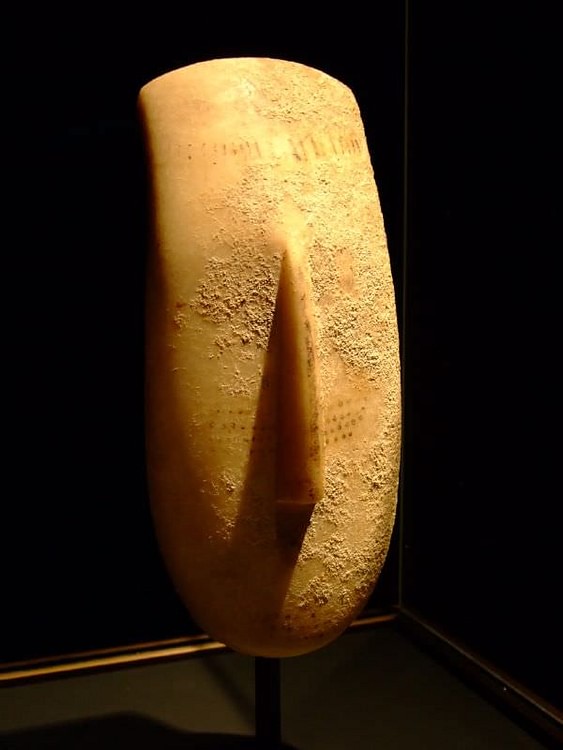
The Cyclades are a group of islands in the southern Aegean situated between the Greek mainland and Turkey. The name was coined in the Archaic period as the islands form an approximate circle ( kyklos ) around the central and most sacred island (at that time) of Delos. The islands had a distinctive culture in the early and middle Bronze Age and regained regional importance during the Archaic and Classical periods.
THE EARLY BRONZE AGE CYCLADES
The Cyclades are made of more than two hundred small islands with the most important being Naxos, Melos, Paros, Thera, Siphnos, Ios, Kea, Andros, Tenos and Mykonos. The islands display evidence of settlement from as early as 5000 BCE, most probably by voyagers from Asia Minor. One of the islands most significant raw materials was obsidian (or volcanic glass) which was used for cutting and was exported throughout the Aegean. Melos was particularly rich in this valuable commodity. In the early Bronze Age lead, copper and marble were also exported. These natural resources led to a certain prosperity which lasted throughout the Bronze Age and which may be divided into three distinct phases: Early, Middle and Late Cycladic.Precise dates for these periods are much disputed and in order to place the islands in a wider geographical context this text will adopt the broader definitions of Early, Middle and Late Bronze Age as seen across the Aegean.
The Early Bronze Age (c. 3000-2200 BCE) saw the establishment of small fishing and rural communities across the archipelago. Buildings often display stone foundations on top of which would have been unbaked clay ( pisé ) superstructures.The most common food crops were barley and wheat with some evidence of olive and vine cultivation. Livestock consisted of sheep, goats, cattle, pigs, and deer. Fish was also an important food source, particularly tuna and perch. Finds of spindle whorls are evidence of weaving craft and pottery finds are abundant, usually of dark vessels with decoration by incisions or white paint designs. Marble was also used to produce vessels and shapes include bowls, beakers, jars, sauceboats and frying pans. These are similar to contemporary pottery on the mainland and Anatolia and suggest cultural ties. Indeed, handled cups of this period may well be of Anatolian origin. Tools were made from bone, stone, shell and obsidian and include axes of emery. Stone graves built from marble slabs and used for multiple burials and fortifications on Syros and Andros are in both cases the first examples of their kind in the Aegean. Clay sealings suggest some sort of administrative apparatus and the minor arts are best represented by jewellery in silver and copper and by the production of small marble figurines. These highly stylised sculptures of human figures are amongst the most distinctive art objects produced throughout the Bronze Age Aegean. Early examples resemble violins but are in fact representations of a squatting female. Later examples are standing figures with arms crossed and minimalistic faces where only the nose is evidenced. Traces of paint on some surviving examples suggest that the figures were brightly painted.
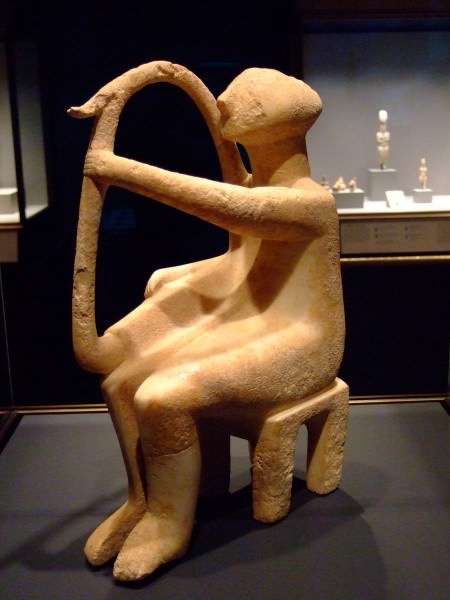
Cycladic Harp Player Figurine
MIDDLE & LATE BRONZE AGE CYCLADES
The Middle Bronze Age (c. 2200-1700 BCE) saw an increase in the size and sophistication of settlements with a more regular town plan achieved. Populations seem also to have become concentrated in larger urban areas. Buildings are also larger and more sophisticated and fortifications become a more common feature of towns. Joining the dark burnished style of pottery is Cycladic White pottery - vessels with a matt wash and decorated with abstract motifs and geometric, floral and spiral designs.Common forms include beaked jugs and shallow bowls. There is also a marked increase in pottery imports from Minoan Creteand the mainland and a continuation in the production of marble figurines, some now being life-size.
CYCLADIC SCULPTURE IS AMONGST THE MOST DISTINCTIVE ART PRODUCED IN THE BRONZE AGE AEGEAN.
In the Late Bronze Age (c. 1700-1000 BCE) the culture of the islands becomes less distinctive and more heavily influenced by Minoan Crete and then from around 1400 BCE by the Mycenaean civilization of mainland Greece. For example, although pottery is still locally produced it increasingly displays elements of Minoan design: sea, animal and plant life realistically depicted in flowing, vibrant forms. There is also a significant increase in the import of Minoan pottery. In particular on Thera, surviving frescoes and architecture (lustral basins and columned rooms) are remarkably similar to those on contemporary Crete. Minoan weight measurements and examples of Linear A script have also been found on the islands. Whether this proximity in art reflects any political or military domination by the Minoans in the Cyclades is, however, uncertain.
Sometime between 1650 and 1550 BCE the volcanic crater of Thera exploded in a cataclysmic eruption completely covering in ash the large town of Akrotiri on the island and creating a destructive tidal wave nine metres high which affected sites across the Aegean. The eruption was the largest witnessed in recorded history and had been preceded by earthquakes of at least 7 on the Richter scale. Such destructive forces must surely have severely affected the civilizations of the Bronze Age Aegean but exactly to what degree is much disputed amongst scholars. Even an approximate date of the event is not yet agreed upon.Ice-core and carbon-dating carried out in the early 2000s CE suggests an earlier than previously thought date for the eruption posing awkward questions for established regional timeframes. What is certain is that the eruption perfectly preserved the town of Akrotiri, giving us an invaluable glimpse of Bronze Age life at that time.
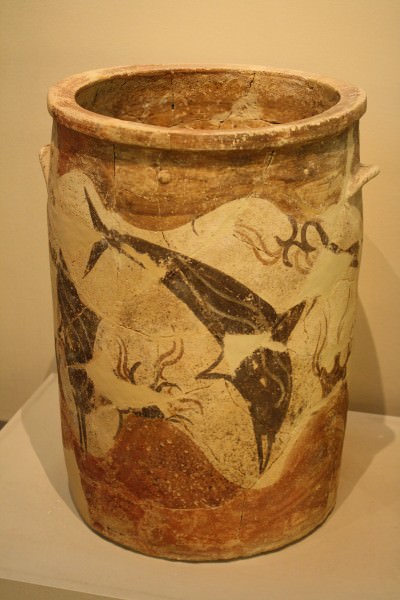
Dolphin Decorated Pithoi, Akrotiri
From around 1400 BCE the Cyclades reflect the rise of the Mycenaean civilization as the dominant culture in the Aegean both in a marked increase in imports of Mycenaean pottery and through architectural features in palaces, particularly at Phylakopi on Melos. The distinctive large tholos tombs of the Mycenaeans are also found on Mykonos, Tenos and Naxos.From 1250 BCE, as in other areas of the Aegean, Mycenaean influence wanes, there is an increase in fortifications of settlements and finally from around 1100 BCE there is evidence of settlement destruction and abandonment.
ARCHAIC & CLASSICAL CYCLADES
The Cyclades returned to some degree of regional importance in the Archaic and Classical periods, particularly the city -states on the islands of Delos and Naxos. Delos was the site of an important sanctuary to Apollo from 700 BCE, indeed, the god and his sister Artemis were born on the island in Greek mythology. Naxos had important temples in honour of Apollo, Demeterand Dionysos, with the latter being born on the island according to mythology. Dionysos was also believed to have married Ariadne on Delos and the occasion was celebrated annually in the Archaic period. In the 8th century BCE Naxos founded the first Greek colony in Sicily and in the 6th century BCE the tyrant Lygdamis, aided by his ally Peisistratus, the tyrant of Athens, led a period of prosperity for Naxos. It was during this period that the temple of Apollo was built and the Dionysia festival - famous throughout the Greek world - was first established to honour Dionysos, god of wine. From the 6th century BCE the island of Paros began to export its fine white Parian marble so valued by Greek sculptors and architects.
During the turbulent 5th century BCE when Persia attempted to conquer Greece, several of the Cycladic islands rose to prominence. Naxos was attacked in 499 BCE and again in 490 BCE by the Persian forces of Darius and the island was a significant member of the united Greek forces which fought and defeated the Persians at the celebrated battles of Salamis in 480 BCE and Plataea in 479 BCE. From 478 BCE many islands were members of the Athenian led Delian League which had its treasury on the island of Delos (until its removal to Athens in 454 BCE) which was established to better repel Persian aggression. The League was not altogether harmonious though as rebellions from Naxos in 469/8 BCE and from northern Thasos in 465 BCE display. Some members were not at all happy at the way Athens began to dominate the League but the powerful maritime state swiftly quashed such uprisings.

Temple of Apollo, Naxos
During the Peloponnesian War (431-404 BCE) between Athens and Sparta and their respective allies, the Cyclades were generally on the Athenian side but there were instances of dissent, perhaps most famously on the island of Melos which had actively supported the Spartans and so was attacked and defeated by Athenian forces from 417 to 415 BCE. All of the island's males were killed and all women and children sold into slavery. When the Second Athenian League was established from 377 to 355 BCE, the islands once again sided with Athens in defence against Sparta but also this time, episodes of rebellion occurred, notably on Keos in 363 BCE.
HELLENISTIC CYCLADES
In Hellenistic times (from the 2nd century BCE) the islands came under the rule of the Ptolemies of Egypt and in Roman times the islands came once again under Athenian rule (166 BCE) but they, nevertheless, enjoyed once more a period of prosperity thanks to their trading position in the Aegean. This period came to a dramatic end though with the attack on Delos in 88 BCE by Mithridates and the subsequent setting up of a pirate base in the archipelago by Athenodoros in 69 BCE. Indeed, the islands' reputation as a safe haven for pirates would last right through to medieval times and beyond. Finally, the last vestiges of the Greek civilization on the islands disappeared when many of the Greek temples were converted into Christian basilica in the 5th and 6th centuries CE. However, from the mid-20th century CE, the world would once again remember the Cyclades' contribution to western European civilization when archaeological excavations revealed the important sites of Akrotiri (on Thera - now Santorini), Ayia Irini (Kea), Phylakopi (Melos), Kastri (Syros), Kavos (Keros), Skarkos (Ios), Paroikia (Paros) and Strophilas (Andros). These sites are still being excavated today and they continue to contribute invaluable insights into life in the ancient Aegean.
Cylinder Seal › Origins
Definition and Origins

Cylinder Seals were impression stamps used by the people of ancient Mesopotamia. Known as kishib in Sumerian and kunukku in Akkadian, the seals were used by everyone, from royals to slaves, as a means of authenticating identity in correspondence. They originated in the Late Neolithic Period c. 7600-6000 BCE in the region known today as Syria (though, according to other claims, they originated later in Sumeria, modern Iraq) and were made from semiprecious stone (marble, obsidian, amethyst, lapis lazuli, to name only some) or metal ( gold or silver ). These seals were worn by their owners on strings of leather or other material around the neck or wrist or pinned to a garment.
The purpose of seals was to serve as a personal signature on a document or package to guarantee authenticity or legitimize a business deal; in the same way one signs a letter or form today or writes one's return address on an envelope or package to be mailed. The seal was rolled onto the moist clay of the document as an offical, binding, signature. Cylinder seals were also used in Egypt and developed completely independently in Mesoamerica as evidenced by archaeological finds of Olmeccylinder seals dating to c. 650 BCE. The Mesopotamian cylinder seal is the best known, however, and was the most widely used.
CYLINDER SEALS & STAMP SEALS
Contemporaneous with cylinder seals were stamp seals which were smaller and less ornate in design. The typical cylinder seal was between 3-4 inches (7-10 cm) long while stamp seals were less than an inch (2 cm) in total and more closely resembled the later signet ring. It would make sense that the stamp seals preceded the cylinder seals as the former are more rudimentary but evidence suggests the seals were in use at the same time with one type favored more than the other in different regions. Scholar Clemens Reichel (whose essay is included in Englehardt's work, Agency in Ancient Writing ) suggests the reason for this was simply a matter of necessity.
A SKILLED ARTIST WAS REQUIRED WHO CARVED THE STORY OF THE INDIVIDUAL ON THE STONE CYLINDER IN EXACTING DETAIL.
Those areas which favored the stamp seal (the regions of modern-day Syria and Turkey ) had no need for the elaborate design imprint of the cylinder seal while the regions to the south, which had a more highly developed bureaucracy, required more detailed information in a seal. The city of Uruk, for example, had a highly complex bureaucracy of different agencies which required detailed information on who was signing what document and, further, which office it originated from. The simpler and smaller stamp seals could not provide the space on which to carve such information while the longer cylinder seals fit the need perfectly. The longer cylinder seals would have provided the name of the agency and name and title of the individual within that agency who was signing the document. In order to accurately represent and identify the owner of such a seal, a skilled artist was required who carved the story of the individual on the stone cylinder in exacting detail.
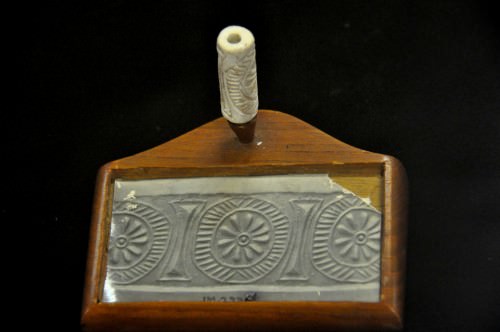
Cylinder Seal from Kish
MANUFACTURE OF SEALS
Cylinder seals were made by a sealcutter known as a burgul in Sumerian and as a purkullu in the Akkadian language. Young sealcutters, probably males, apprenticed with a master sealcutter for at least four years before setting up their own shop as a professional.
The seal-makers tools consisted of copper chisels and gravers, a whetsone, a borer, and saws for cutting through stone.Scholar Stephen Bertman claims that "rather than cutting rough cylinders from stone, the sealcutters may have bought blanks from dealers, adding the finishing touches in their workshops" (233). Once the seal was carved, or perhaps before work was begun on the blank, holes were drilled into the cylinder so that the owner could wear it on a string or pin it to a garment.
The seals were carved in intaglio, a process of carving beneath the surface of the stone so an impression of that carving creates an image in relief (what one would know today as a `photographic reverse' or a negative). In order to achieve this effect, the artist would have had to reverse the image he wanted to create as he worked. This required enormous skill and sealcutters were highly paid and greatly respected for their craft.
STYLES & USES OF SEALS
The two styles of seals are the Uruk-Style and the Jemdet Nasr-Style which refer to the motifs used and the way the seals were carved. Authors Megan Lewis & Marian Feldman note their differences:
The Uruk-style seals show animals and figures depicted in an exceptionally naturalistic fashion, suggesting that the seal carvers were aiming for expressive clarity. The motifs include ritual narratives involving temples, boats and offerings to gods, as well as depictions of the natural world in hierarchical arrangements. They are skillfully cut, detailed, and their composition tends to be balanced and aesthetically pleasing. The Jemdet Nasr-style seals are less detailed than Uruk-style seals and are characterized by the heavy use of drills and cutting discs, which produce round and linear marks respectively. Common motifs from the Jemdet Nasr-style include women with pigtails involved in domestic labor and herds of animals in front of temples (4).
The uses of the seals were both practical and spiritual. Lewis and Feldman note the practical uses of signing one's name, restricting access only to those allowed to break the seal, and as a means of personal identification. The spiritual use was `amuletic', which refers to the Mesopotamian belief in the seal as an amulet, a kind of charm, which could ward off evil spirits and protect one from harm or bring one luck.
The seal of a ruler, of course, demonstrated that individual's strength and ability to govern. The Mesopotamians saw their existence as a cooperative venture with the gods to maintain order and hold back the primordial forces of chaos. The king, as intermediary between the people and the gods, would have to be exceptionally adept at this kind of balance. In a famous seal from the region of Persia, an unknown king controls chaos as symbolized by the two griffin-like creatures on either side of him. The monarch stands at the center of this seal's story, stately and in control, while he holds the creatures by their manes, keeping chaos in check and maintaining order. The identity of the king is signified by the symbols on the left of the central image. This particular seal would have been used by the ruler in signing all decrees and pronouncements and, everytime anyone saw it, they would be reminded of that king's stature.
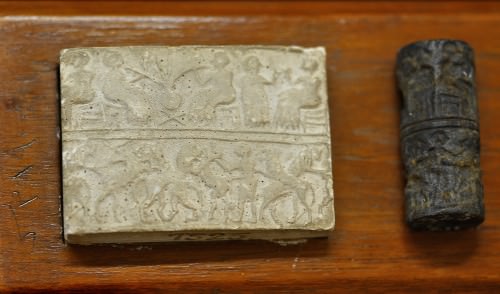
Cylinder Seal
Regardless of what purpose it was put to, the seal was a prized possession and its loss was taken as seriously as people today regard the loss of their personal ID or credit cards. Bertman writes how, if someone lost their seal, "the former owner would record the date and time of loss with an official to insure that transactions made after the loss would be invalid" (235).Since the seals conveyed one's occupation, official position, and even one's name, the loss was significant. One's personal identity was made clear either by the likeness engraved on the seal or by symbols surrounding an image. For example, if one were a weaver one's occupation would be symbolized by a spider (which weaves a web) and symbols around the spider image would give the individual's name. The loss would have been as serious to an ancient Mesopotamian as the danger of "identity theft" is in the modern day as one's seal not only served as personal identification but as a symbol of one's authority and position in society.
CONCLUSION
The cylinder seal was used for all correspondence and for business transations requiring an official signature in order to be considered valid. Land deals, marriage contracts, sales of goods, royal decrees, and religious declarations all required the personal signature of the presiding official or participants involved. Historians and scholars, especially art historians, have long appreciated the significance of the seals for their beauty and craftsmanship but also for the story they tell of the past. The cylinder seal is a snapshot of the period in which is was made and of the individual who used it and, as such, is an intimate glimpse into the daily life of the ancient Mesopotamians.
Third Gender Figures in the Ancient Near East › Origins
Ancient Civilizations
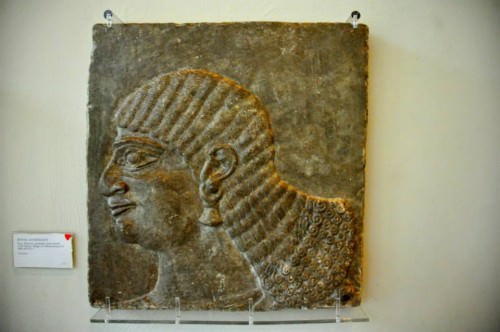
Alabaster Relief of an Assyrian Royal Attendant
According to a recent argument by Ilan Peled, author of Masculinities and Third Gender, men with normative masculinities attempted to maintain clear, distinguished differences between men and women by institutionalizing non-normative men as third gender figures. This allowed those of normative masculinity to define "clear social markers of rules of conduct and normative behavior patterns" (Peled, 294).
GALA & KALǓ
Before the kalǔ, the Sumerian gala worked as a "chanter of laments" and was not associated with any particular deity. Simply working as a professional lamenter categorized him as feminine because laments were typically performed by women. During the Old Babylonian period, the role of the gala expanded, became a synonym of kalǔ, and was incorporated into the cult of Ishtar. The kalǔ, like the gala in the Sumerian period, was considered a singer and was in charge of many rituals related to music and song. Beyond association with cult practice, association with Ishtar reinforced the gender ambiguity of the kalǔ. In Lady of Largest Heart, a composition for Ishtar, we read a revealing characteristic about her: "Turning a male into a female and a female into a male is yours" (Sjöberg, 190). This perceived ability is important because it demonstrates how the kalǔwere institutionalized into religious practice and ritual of Ishtar in order to maintain strong social distinctions between men, women, and the third gender, characterized as ambiguous, like Ishtar.
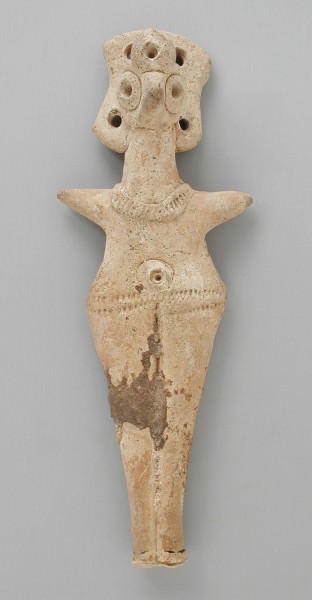
Ishtar
ASSINNU & KURGARRǓ
Like the kalǔ, the assinnu may be understood as ambiguous as a result of being institutionalized into the cult of Ishtar, a gender-ambivalent deity. Throughout texts referring to the assinnu, the figure is often represented as being a passive male, at one point "listed among a group of female cultic attendants" (Peled 2016: 283). As mentioned above, the male was supposed to be sexually active while the female took on the passive role. Because of the assinnu's passivity, he was categorized as a third gender figure.
The kurgarrǔ was often associated with the assinnu, gala, and kalǔ. In the case of the kurgarrǔ, though, he is often represented with weapons, especially daggers and swords. Some scholars consider this evidence of apparent self-mutilation or castration; yet, as Peled notes, references to actual self-mutilation never occur. Thus, according to Peled, kurgarrǔ were part of the cultic performance for Ishtar as militant and masculine. The kurgarrǔ can be considered a third gender figure due to his involvement in the cult of Ishtar and association with other third gender figures.
LΎ-SAG & ŠA RĒŠI
MEN WITH NORMATIVE MASCULINITIES ATTEMPTED TO MAINTAIN CLEAR, DISTINGUISHED DIFFERENCES BETWEEN MEN & WOMEN BY INSTITUTIONALIZING NON-NORMATIVE MEN AS THIRD GENDER FIGURES.
lύ-sag and ša rēši are synonymous terms for the same figure: a palace attendant typically in charge of women's quarters within a palace. They were permitted to do so because they were castrated and eunuchs. Attestation of this figure as castrated is only apparent, though, in the Middle and Neo-Assyrian periods. While they functioned in the same manner prior to these periods, evidence of castration is lacking. Some lύ-sag / ša rēši even acted as military commanders. As eunuchs, though, they maintained some masculine gender identity. For virility could still be maintained were the castration only partial. Even so, the consequences of castration meant they were not considered normative in regard to masculinity, hence their institutionalization in royal bureaucracies as military commanders or people in charge of women's quarters.
OTHER THIRD GENDER FIGURES
Unfortunately, there is not enough textual evidence to provide a complete image of third gender figures. However, a few others may be worth mentioning: girseqû, a childless male figure within palace administration; tiru / tīru, likely a childless castrate and part of palace bureaucracy; SAG- UR -SAG, “effeminate cultic personnel similar to the assinnu … after the end of the Old Babylonian period the office of the SAG-UR-SAG ceased to exist” (Peled 2016, 267); and pilpilû, a member of the Ishtar cult with feminine traits.
Men throughout the ancient Near East were marginalized by men of normative masculinity for improper adherence to the social order. As Peled notes, "
Members of the third gender were not excluded from mainstream society because of their peculiarity. On the contrary, they were invented and re-invented each period by hegemonic [or normative] masculine men of their own society…, social anomalies who constituted an integral part of their society. (Peled, 294)
LICENSE
Article based on information obtained from these sources:with permission from the Website Ancient History Encyclopedia
Content is available under License Creative Commons: Attribution-NonCommercial-ShareAlike 3.0 Unported. CC-BY-NC-SA License